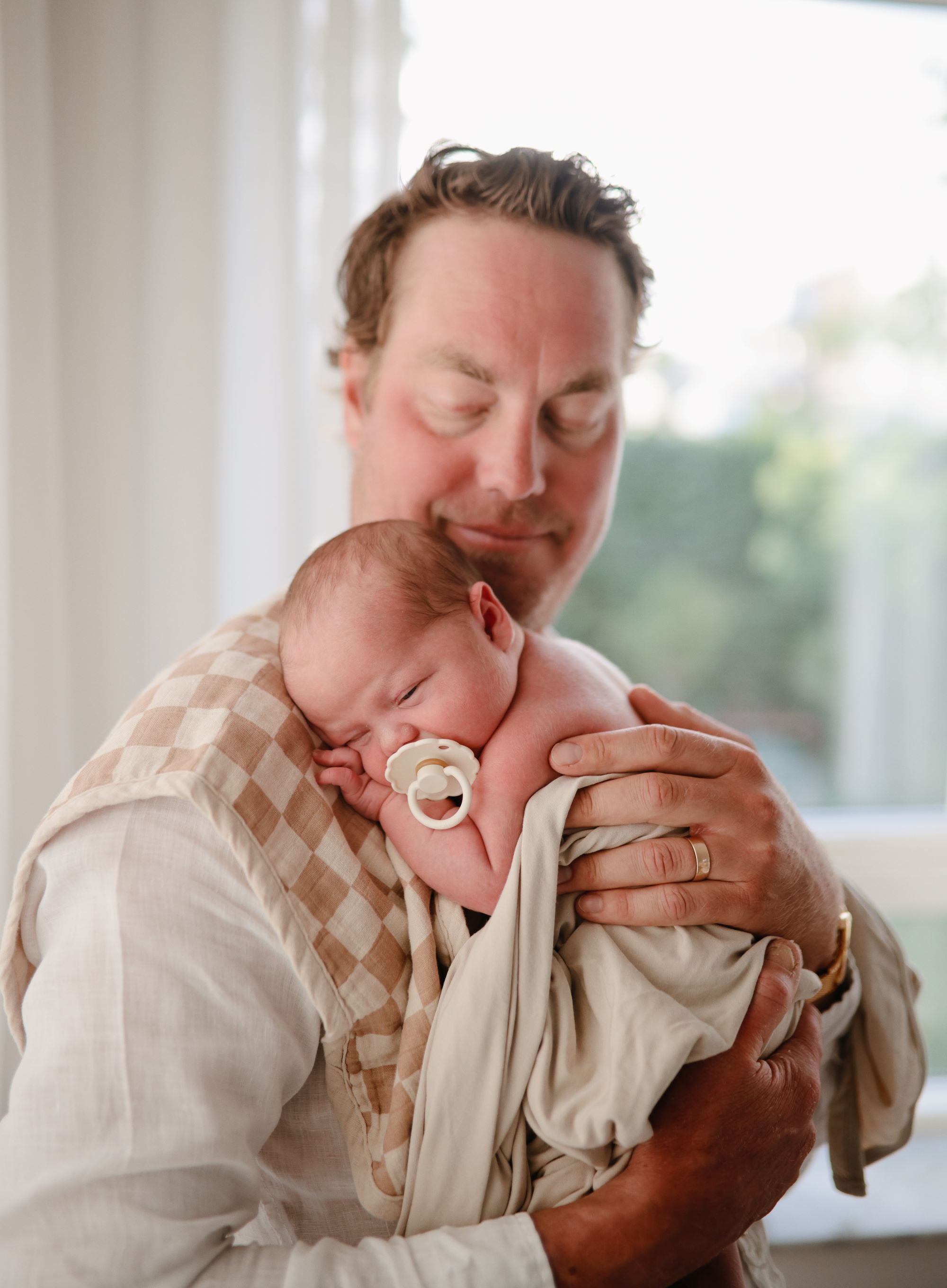- Why Do You Need to Swaddle?
- What is the Moro Reflex?
- Is Swaddling Safe?
- Does Swaddling Reduce the Risk of Sudden Infant Death Syndrome (SIDS)?
- Will Swaddling Make My Baby Sleep So Soundly That It's Dangerous?
- Can Swaddling Be Dangerous?
- Can Swaddling Hinder Baby's Development?
- Is Swaddling Something New?
- When to Stop Swaddling?
- So Will We Change Our Views About Swaddling?
Should I Swaddle My Baby?
This topic is often asked by parents-to-be about swaddling babies! Why do we need to swaddle? Does swaddling make babies safer? What is the correct way to swaddle? Can swaddling delay important development? When should I start or stop swaddling? Is swaddling the right choice for my baby?
Here we’ll help answer all of these questions, based not only on personal experience but also on evidence-based research, so you can make the best decision about swaddling for your family.
Why Do You Need Swaddling?
In the womb, babies grow and develop in a small, comfortable space. This small space provides a sense of security and comfort for the baby in the womb, and swaddling helps recreate a similar environment outside the womb for the newborn. The tightness of the swaddle also helps calm the Moro reflex when the baby is trying to sleep.
Swaddling really does provide a sense of comfort and security. For premature babies, swaddling can provide benefits such as: "better neuromuscular development, less physiological stress, more organized motor skills, and better self-regulation skills." Studies have also shown that full-term babies cry less when swaddled compared to other soothing techniques, and "swaddling can provide pain relief for infants." (1)
Is that clear? Swaddling can be amazing for babies! If your baby doesn’t like being swaddled, don’t stop reading now! The 7 Newborn Sleep Tips blog can help you.
What is the Moro Reflex?
Have you ever seen a newborn baby suddenly throw their arms back and start crying when you put their head down or when they hear a loud noise? That's the Moro reflex. Imagine how disruptive that reflex is when a baby is trying to sleep!
Swaddling helps calm the Moro reflex and keeps those sweet little arms from flailing around wildly as baby tries to sleep.(2,3) That's what makes swaddling such a powerful tool, especially for newborns.
The Moro reflex usually fades and disappears between 3 and 6 months of age. Keep in mind that this reflex is an involuntary response, meaning that it will not last longer or disappear faster just because your baby is swaddled or unswaddled.
Is Swaddling Safe?
Yes, it is safe! Swaddling is safe as long as you follow the guidelines recommended by the American Academy of Pediatrics (AAP). (4,5)
According to the AAP (4), "when done correctly, swaddling can be an effective technique to soothe babies and help them sleep." The Canadian Society of Paediatrics (6) also agrees and says that "swaddling is safe when done correctly."
A safely swaddled baby:
- there is no risk of having your nose or mouth covered by a swaddle,
- have enough room for the hips,
- swaddled tightly but still able to breathe easily, with a snug chest, but still room for your hands to fit in,
- not sweating, flushing, or showing signs of overheating,
- placed safely on his back. Stop swaddling when your baby starts to show signs of rolling over.
I highly recommend using swaddles with velcro or zippers to make the swaddling process safer and easier.
Does Swaddling Reduce the Risk of Sudden Infant Death Syndrome (SIDS)?
Yes! There’s evidence that swaddling can reduce the risk of SIDS. Parents, we know: SIDS is scary. Not to add to your stress, but if there’s one tool that can make things a little easier and a little less scary, why not?
We know that “back is best” for sleeping because it reduces the risk of SIDS. Research shows that swaddling helps keep babies safely sleeping on their backs. There is some interesting research (8) on the history of swaddling and concerns about SIDS if you want to read more.
Some parents may be tempted to put their newborns to sleep on their stomachs despite knowing this recommendation. They may think that their babies will sleep better on their stomachs. However, research (7) has shown that while babies who sleep on their stomachs wake up less, it is still not safe.
Swaddling helps babies sleep soundly while staying safe. If you find that your baby doesn’t like being swaddled or can only sleep on their stomach, you’re not alone: find and take baby classes specifically on the topic of swaddling or read 7 Tips for Newborn Sleep Through the First 5 Months .
Does Swaddling Make Babies Sleep So Soundly That It's Dangerous?
You must have searched for validation and heard a lot of information out there. I know you are doing what is best for your baby. You may have heard someone say that swaddling is dangerous because swaddled babies sleep too soundly.
We will try to help explain the following research.
Some people may use this study (7) when talking about swaddling and the startle reflex. You may have read this: "Swaddling has a significant effect in inhibiting the development of arousal from the brainstem to full arousal involving the cortex in the QS. Swaddling reduces spontaneous arousal in the QS and increases the duration of REM sleep, possibly by helping the infant return to sleep spontaneously, which may limit parental intervention."
In simple terms, this means that if your baby is swaddled, he or she may be able to sleep so deeply that you don’t have to wake him or her up. This deep sleep may sound appealing to you, or it may sound scary because you’re worried that this deep sleep may not be good for your baby.
But, we must continue reading: this conclusion (next sentence) is often not mentioned when shared on social media: "For this reason, a secure swaddle that allows hip flexion/abduction and chest wall expansion may help parents maintain their infants in a supine sleep position and thereby prevent the risk of sudden infant death syndrome associated with the prone sleep position." (7)
Is it obvious? Don't miss this! This study concludes that because babies sleep so soundly, swaddling is GOOD. This study says, unequivocally, that swaddling can help prevent SIDS.
Can Swaddling Harm Babies?
In this study (1), harm only occurred if swaddling was not done safely OR if parents continued swaddling after the baby could roll onto their tummy. This is why safe swaddling is so important! This study discusses many of the potential risks of improper swaddling, but never mentions concerns about developmental delays or neurological consequences of swaddling.
Can Swaddling Hinder Baby's Development?
Research does NOT show that swaddling is detrimental to a baby's development!
In one study (1), it was stated directly that “there is no evidence that swaddling has any short-term or long-term effects on achievement of motor milestones.”
Another study (9) that looked at swaddling babies for a long period of time (over 7 months) showed that swaddled and unswaddled babies did not have significant differences in early mental or psychomotor development. Now, because of safety concerns, swaddling is NOT recommended once babies can roll over on their own. However, even in cultures where swaddling is practiced for babies older than 7 months, studies have shown no developmental concerns related to swaddling.
Again, hear this: no one ever recommends swaddling babies once they start showing signs of rolling over on their own, as the American Academy of Pediatrics (AAP) recommends(5). On the other hand, there is research that shows that swaddling has no negative effects on development.
Is Swaddling Something New?
That's a great question! The short answer is, no! Swaddling has been around for centuries.
Swaddling is an ancient practice that exists in many cultures (1) and has been used for centuries in both medical and child care practices. Swaddling has recently become popular in Western cultures due to the “back is best” recommendation that began in the 1990s. However, that doesn’t mean swaddling only started in the last 30 years.
One study (1) even called swaddling a “nearly universal child care practice before the 18th century.” Swaddling has long been a strategy for soothing babies.
Despite all this, for us, history (8) alone is not enough. Several specific studies on the benefits of swaddling listed in the references section below should reassure parents that swaddling, when done according to safety guidelines, is not only safe but also beneficial for your baby!
When to Stop Swaddling a Baby?
For safety reasons, you should stop swaddling when your baby starts showing signs of rolling over. If you have questions about this transition, you can read our blog on how to transition out of swaddling .Once your baby transitions out of the swaddle, tummy sleeping can be safe once your baby can roll onto their tummy on their own. However, for the first 12 months, you should always put your baby to sleep on their back, and let them roll onto their tummy if they choose.
Are We About to Change Our Views on Swaddling?
If there is ever evidence-based research that shows concerns about swaddling, by all means! We are always adapting as we learn new things, and we always encourage parents to be open to new research and make recommendations based on what evidence-based science says.Do I Have to Swaddle My Baby to Get Healthy Sleep Patterns?
We know that science shows that swaddling, when done correctly, is safe. That’s why swaddling is highly recommended in newborn classes. (Note that in our blogs 7 Tips for Newborn Sleep Through the First 5 Months and 4 Ways to Transition From Swaddling , we also cover how to transition from swaddling. Swaddling is only suitable for babies who can’t roll over yet.)
However, if swaddling isn’t right for you or your baby for whatever reason, as parents we would never advise you to swaddle beyond what is comfortable. Our goal is simply to provide you with tools that will help your family thrive.
We are on your team. I want you to thrive and have a wonderful time with your baby!
- Van Sleuwen et al. (2007). Swaddling: A Systematic Review
- Lauren Vinopal. (2022). The Moro Reflex: Why your Sleep Baby Suddenly Freaks Out
- Futagi, Y., Toribe, Y., & Suzuki, Y. (2012). The Grasp Reflex and Moro Reflex in Infants: Hierarchy of Primitive Reflex Responses
- Healthy Children, American Academy of Pediatrics. (2022). Swaddling: Is it safe for your baby?
- American Academy of Pediatrics. (2016). SIDS and Other Sleep-Related Infant Deaths: Recommendations for a Safe Infant Sleeping Environment
- Canadian Pediatric Society. (2018). Swaddling .
- Gerard, Harris, and Thach. (2002). Spontaneous Arousals in Supine Infants While Swaddled and Unswaddled During Rapid Eye Movement and Quiet Sleep
- Brittany Clair. (2017.) It's a Wrap: The Science of Swaddling
- Manaseki-Holland et al. (2010). Effects of Traditional Swaddling on Development: A Randomized Controlled Trial
































































































